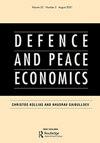军费开支对不同收入群体国家经济增长的明显不对称效应
IF 1.6
3区 经济学
Q2 ECONOMICS
引用次数: 1
摘要
摘要尽管单变量和多变量动力学的可能不对称性一直是许多经济探索领域关注的焦点,但似乎大多数关于军费支出-经济增长关系的研究都倾向于假设线性关系。本文旨在利用1988-2019年期间103个国家的样本数据,研究军费支出与经济增长之间可能存在的非线性关系。为此,面板平滑过渡回归(PSTR)模型不仅针对所有国家的样本,而且针对低收入、中等收入和高收入国家的子样本进行了估计,以揭示不同收入水平的国家群体可能存在的明显不对称关系。对整个样本、低收入和中等收入群体的实证结果表明,军费开支不仅支配着政权的更迭,而且低水平和高水平的军费开支对经济增长的负面影响也明显且呈上升趋势,具有不同的阈值效应。此外,实证研究结果还表明,武器净出口决定了高收入国家的制度变化,随着武器净出口的增加,军费开支对经济增长的负面影响越来越深。本文章由计算机程序翻译,如有差异,请以英文原文为准。
Distinct Asymmetric Effects of Military Spending on Economic Growth for Different Income Groups of Countries
ABSTRACT Although possible asymmetries for univariate and multivariate dynamics have been the focus of interest in many areas of economic explorations, it seems that most of the research on military expenditure - economic growth nexus has tended to assume linear relationships. This paper aims to examine possible nonlinearities in military expenditure-economic growth nexus employing data for a sample of 103 countries covering the 1988-2019 period. For this purpose, Panel Smooth Transition Regression, PSTR, models are estimated not only for all countries’ sample but also for low income, middle income, and high-income countries’ subsamples to reveal possible distinct asymmetric relationships for country groups with different income levels. Empirical results for the whole sample, low income and middle income groups indicate that military expenditure not only governs the regime change, but also low and high levels of military expenditure have distinctive and rising negative effects on economic growth with dissimilar threshold effects. Moreover, empirical findings also indicate that net arms exports govern regime change for high income countries, and as net arms exports rise, the negative impacts of military expenditure on economic growth become deeper.
求助全文
通过发布文献求助,成功后即可免费获取论文全文。
去求助
来源期刊

Defence and Peace Economics
ECONOMICS-
CiteScore
4.00
自引率
18.80%
发文量
45
期刊介绍:
Defence and Peace Economics embraces all aspects of the economics of defence, disarmament, conversion and peace. Examples include the study of alliances and burden-sharing; military spending in developed and developing nations; arms races; terrorism; country surveys; the impact of disarmament on employment and unemployment; the prospects for conversion and the role of public policy in assisting the transition; the costs and benefits of arms control regimes; the arms trade; economic sanctions; the role of the United Nations.
 求助内容:
求助内容: 应助结果提醒方式:
应助结果提醒方式:


